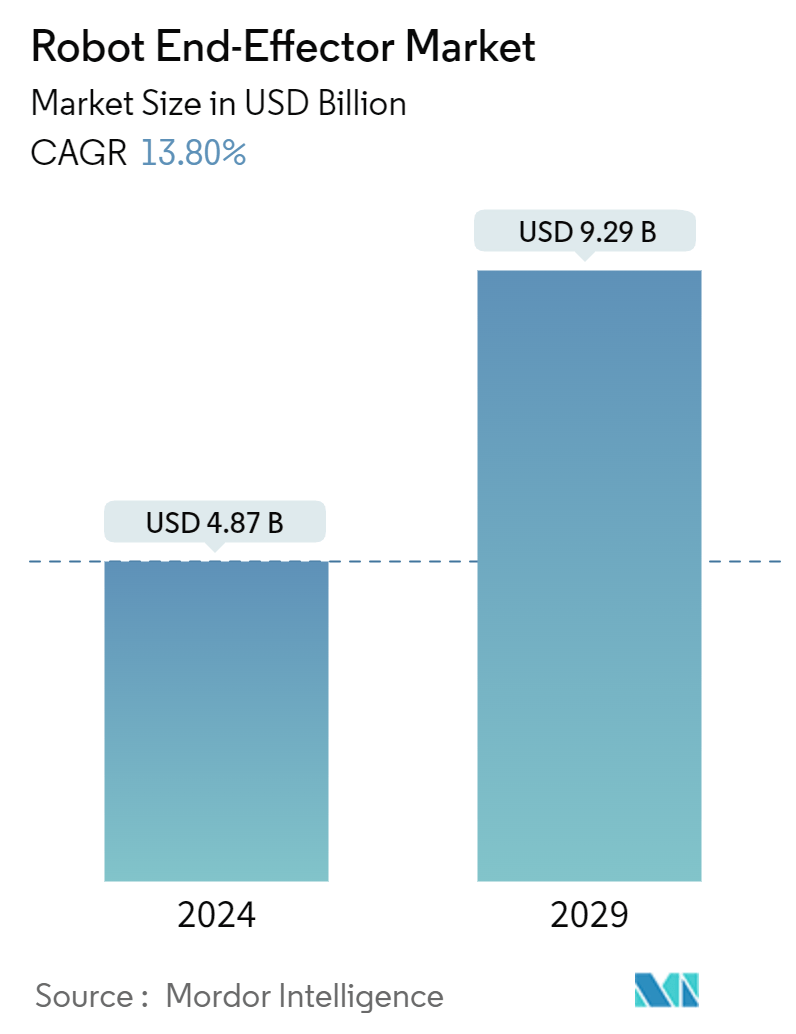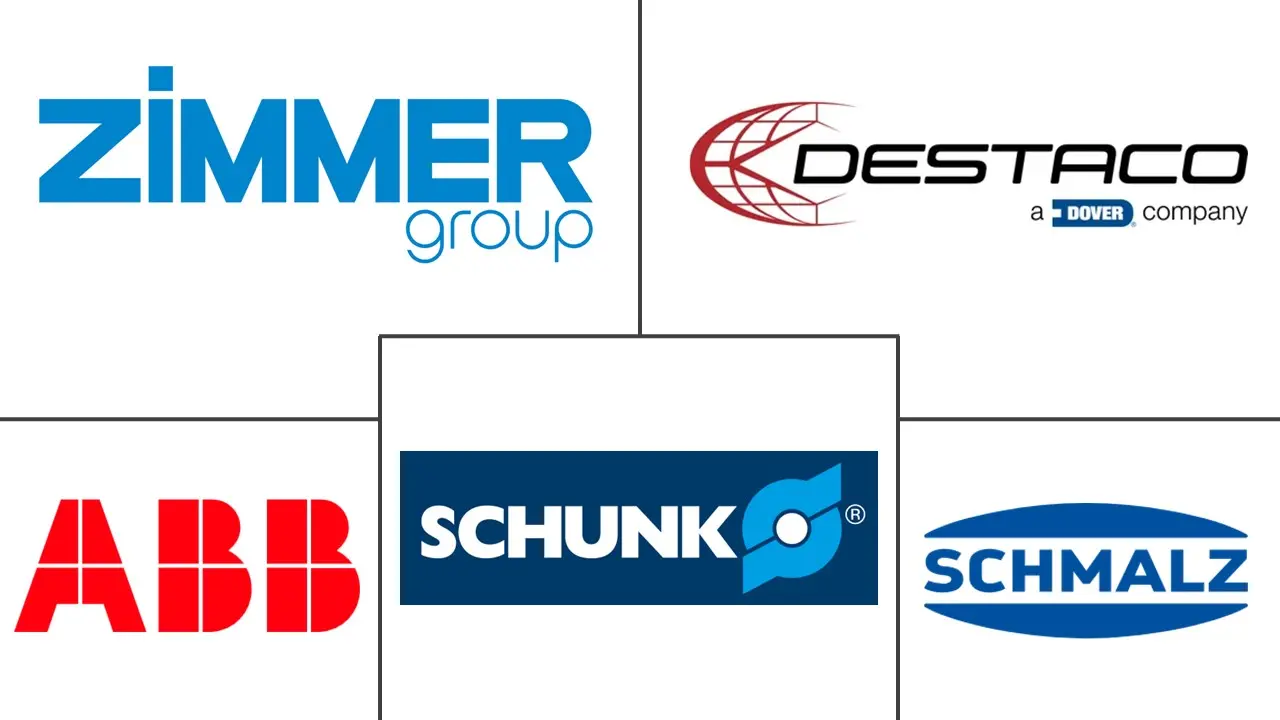Market Size of Robot End-Effector Industry

| Study Period | 2024 - 2029 |
| Market Size (2024) | USD 4.87 Billion |
| Market Size (2029) | USD 9.29 Billion |
| CAGR (2024 - 2029) | 13.80 % |
| Fastest Growing Market | Asia Pacific |
| Largest Market | Asia Pacific |
Major Players
*Disclaimer: Major Players sorted in no particular order |
Robot End Effector Market Analysis
The Robot End-Effector Market size is estimated at USD 4.87 billion in 2024, and is expected to reach USD 9.29 billion by 2029, growing at a CAGR of 13.80% during the forecast period (2024-2029).
- The integration of various technologies, including artificial intelligence, automation, the Internet of Things, computing power, and robotics, facilitates the building of a new generation of smart factories. Robotics and automation have changed significantly over the past few years. In the continuously growing range of industries such as electronics, automotive, food and metalworking, and material handling, increasing investment in advanced automation creates ample opportunities for robots, thus driving end-effector demand.
- Robots work even more closely with humans, so they must respond to the users and adapt their behaviors. Over the next few years, researchers are expected to recognize basic human behaviors and adapt these robots’ actions to respond to them. Over the next few years, this will develop into much more advanced programs adapting to complex tasks’ needs. From the intelligent lift assist devices built to lift weight safely without motion power of their own to the emergence of the first cobots that came with vision-integrated systems for obstacle avoidance, the market is expected to grow even further.
- Collaborative robots are becoming increasingly affordable, less complex, and more accessible to use. This will provide multiple options to the organizations, augmenting the demand for collaborative robots in the market. Collaborative robots enable enterprises of all scales and sizes to stay competitive as these robots utilize plug-and-play technologies, advanced sensors, and automatic robot programming from CAD data. Players in the market are also expanding their operations through strategic mergers & acquisitions. Thus, the rapid adoption of collaborative robots results in the rapid growth of end-effectors.
- The main limitations of robot end-effectors have been observed in terms of their slow speed relative to human pickers, the inability of the vision system and gripper to deal with unusual items, and the reliability of being fully autonomous. The companies in the market studied have demonstrated some degree of success in picking individual items out of totes. However, the remaining half of the companies face various challenges when it comes to implementing these systems on a larger scale.
- The COVID-19 pandemic significantly impacted the robot end-effector market due to the workforce shortage, the shutdown of manufacturing facilities to restrict the spread of the virus, and nationwide lockdowns, leading to a downturn in robot manufacturing. According to IFR, Around 283,000 industrial robots were shipped worldwide in 2018 and it decreased to 250,000 in 20219 . Asia/Australia had the highest number of units installed, with an estimated 266,000 units fitted in 2020 alone. By 2024, industrial robot installations in Asia/Australia are projected to reach 370,000 units.
Robot End Effector Industry Segmentation
End-effectors are peripherals connected to robot arms. These are specifically designed to perform tasks such as picking, moving, and placing dry or prepreg reinforcements, as well as perform industrial process requirements such as painting and welding, to name a few. The robot end-effector market is defined in terms of the revenue accrued by the vendors' products offered in the market.
The robot end-effector market is segmented by type (grippers, processing tools, suction cups, and other types), by end-user industry (automotive, food and beverage, e-commerce, pharmaceutical, and other end-user industries), by geography (North America, Europe, Asia-Pacific, and the rest of the World). The report offers market forecasts and size in value (USD) for all the above segments.
| By Type | |
| Grippers | |
| Processing Tools | |
| Suction Cups | |
| Other Types |
| By End-user Industry | |
| Automotive | |
| Food and Beverage | |
| E-commerce | |
| Pharmaceutical | |
| Other End-user Industries |
| By Geography*** | |
| North America | |
| Europe | |
| Asia | |
| Australia and New Zealand | |
| Latin America | |
| Middle East and Africa |
Robot End-Effector Market Size Summary
The robot end-effector market is poised for significant growth, driven by the integration of advanced technologies such as artificial intelligence, automation, and the Internet of Things. This integration is facilitating the development of smart factories, particularly in industries like electronics, automotive, food, metalworking, and material handling. The demand for robot end-effectors is increasing as these industries invest in advanced automation solutions. Collaborative robots, or cobots, are becoming more affordable and accessible, further boosting market demand. These robots, equipped with plug-and-play technologies and advanced sensors, are enhancing productivity and efficiency across various sectors. Despite challenges such as slower speeds compared to human pickers and limitations in handling unusual items, the market is witnessing rapid adoption and expansion through strategic mergers and acquisitions.
The automotive industry is a major adopter of robotics and automation, utilizing robot end-effectors for tasks such as welding, painting, and material handling. This sector's push towards Industry 4.0, with connected machines and enhanced workplace safety, is driving the demand for collaborative robots and end-effectors. The Asia-Pacific region, particularly countries like Japan and China, is experiencing swift industrialization and modernization, leading to increased adoption of robotic systems. China's 'Made in China 2025' policy is further propelling the market's growth. The market is highly fragmented, with both global players and SMEs competing through partnerships and acquisitions to enhance their offerings. Recent innovations, such as SCHUNK's automated solutions and Schmalz's vacuum surface gripping systems, highlight the ongoing advancements in the field, catering to emerging industries like e-mobility and electronics.
Robot End-Effector Market Size - Table of Contents
-
1. MARKET INSIGHTS
-
1.1 Market Overview
-
1.2 Industry Attractiveness - Porter's Five Forces Analysis
-
1.2.1 Bargaining Power of Suppliers
-
1.2.2 Bargaining Power of Buyers
-
1.2.3 Threat of New Entrants
-
1.2.4 Threat of Substitutes
-
1.2.5 Intensity of Competitive Rivalry
-
-
1.3 Industry Value Chain Analysis
-
1.4 Impact of Macro-economic Trends in the Market
-
-
2. MARKET SEGMENTATION
-
2.1 By Type
-
2.1.1 Grippers
-
2.1.2 Processing Tools
-
2.1.3 Suction Cups
-
2.1.4 Other Types
-
-
2.2 By End-user Industry
-
2.2.1 Automotive
-
2.2.2 Food and Beverage
-
2.2.3 E-commerce
-
2.2.4 Pharmaceutical
-
2.2.5 Other End-user Industries
-
-
2.3 By Geography***
-
2.3.1 North America
-
2.3.2 Europe
-
2.3.3 Asia
-
2.3.4 Australia and New Zealand
-
2.3.5 Latin America
-
2.3.6 Middle East and Africa
-
-
Robot End-Effector Market Size FAQs
How big is the Robot End-Effector Market?
The Robot End-Effector Market size is expected to reach USD 4.87 billion in 2024 and grow at a CAGR of 13.80% to reach USD 9.29 billion by 2029.
What is the current Robot End-Effector Market size?
In 2024, the Robot End-Effector Market size is expected to reach USD 4.87 billion.

